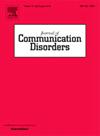墨西哥准教师嗓音症状的患病率及相关因素:一项横断面研究
IF 2.1
3区 医学
Q2 AUDIOLOGY & SPEECH-LANGUAGE PATHOLOGY
引用次数: 0
摘要
目的本研究旨在确定墨西哥准教师嗓音症状的患病率及相关因素。方法本横断面研究于2023年秋季进行。数据是从参与机构提供的所有四年教师教育项目中收集的。四所院校共有1233名学生参与。在完成问卷之前,学生们阅读并签署了一份知情同意书,其中概述了研究的细节和他们的权利。为本研究开发了一份基于网络的自我报告问卷,包括以下内容:(1)人口统计信息,(2)教育信息,(3)生活习惯,以及(4)因发声症状而使用的卫生保健服务。此外,参与者还完成了西班牙语版的声音症状量表(VoiSS)、声音疲劳指数(VFI)和声音障碍筛查指数(SIVD)。结果嗓音症状的发生率随器械使用的不同而不同。实习中对灰尘的感知是与不同量表报告的声音症状相关的最显著的教学培训条件(VoiSS, OR = 2.00;SIVD, OR = 2.08),与声音疲劳(VFI因子1)相关(OR = 1.72)。第三年培训的准教师或刚开始实习的教师更有可能报告使用所有量表(VFI因子1和2、VoiSS和SIVD)测量的声音症状。讨论与结论在体验教师职业的全部职业声音需求之前,准教师可能会接触到增加其报告声音症状可能性的教学培训条件。在未来教师培训期间,通过识别相关需求和声音症状的普遍程度,可能有机会实施早期干预和教育计划。本文章由计算机程序翻译,如有差异,请以英文原文为准。
Prevalence and associated factors of voice symptoms among Mexican prospective teachers: A cross-sectional study
Aims
This study aimed to determine the prevalence and associated factors of voice symptoms among Mexican prospective teachers.
Method
This cross-sectional study was conducted in the fall of 2023. Data was collected from all four years of the teacher education program offered by participating institutions. A total of 1233 students participated across the four institutions. Before completing the questionnaire, students read and virtually signed an informed consent form outlining the study's details and their rights. A self-report web-based questionnaire was developed for this study consisting of the following: (1) demographic details, (2) educational details, (3) lifestyle habits, and (4) use of health care services due to voice symptoms. Further, participants completed the Spanish version of the Voice Symptom Scale (VoiSS), the Vocal Fatigue Index (VFI), and the Screening Index for Voice Disorder (SIVD).
Results
The prevalence of voice symptoms varied depending on the instrument used. The perception of dust in the practicum placement was the most significant teaching-training condition associated with voice symptoms reported using different scales (VoiSS, OR = 2.00; SIVD, OR = 2.08) and being statistically associated with tiredness of voice (Factor 1 of the VFI) (OR = 1.72). Prospective teachers in their third year of training or who were starting their practicum placement were more likely to report voice symptoms measured using all the scales (VFI Factors 1 and 2, VoiSS, and SIVD).
Discussion and conclusion
Before experiencing the full occupational vocal demands of the teaching profession, prospective teachers may be exposed to teaching-training conditions that increase their likelihood of reporting voice symptoms. There may be an opportunity for implementing early intervention and education programs by identifying associated demands and the prevalence of voice symptoms during prospective teachers’ training.
求助全文
通过发布文献求助,成功后即可免费获取论文全文。
去求助
来源期刊

Journal of Communication Disorders
AUDIOLOGY & SPEECH-LANGUAGE PATHOLOGY-REHABILITATION
CiteScore
3.30
自引率
5.90%
发文量
71
审稿时长
>12 weeks
期刊介绍:
The Journal of Communication Disorders publishes original articles on topics related to disorders of speech, language and hearing. Authors are encouraged to submit reports of experimental or descriptive investigations (research articles), review articles, tutorials or discussion papers, or letters to the editor ("short communications"). Please note that we do not accept case studies unless they conform to the principles of single-subject experimental design. Special issues are published periodically on timely and clinically relevant topics.
 求助内容:
求助内容: 应助结果提醒方式:
应助结果提醒方式:


